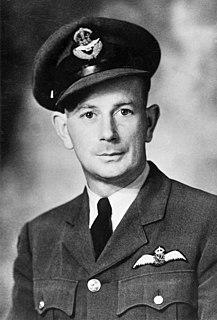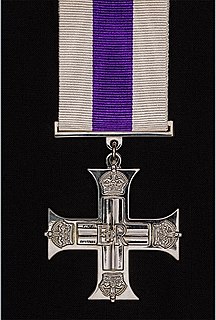Related Research Articles

The Distinguished Flying Cross (DFC) is the third-level military decoration awarded to officers, and since 1993 to other ranks, of the United Kingdom's Royal Air Force and other services, and formerly to officers of other Commonwealth countries, for "an act or acts of valour, courage or devotion to duty whilst flying in active operations against the enemy".

Flying Officer Lloyd Allan Trigg VC DFC, of Houhora, New Zealand, was a pilot in the RNZAF during World War II. He was a posthumous recipient of the Victoria Cross, the highest award for gallantry in the face of the enemy for British and Commonwealth armed forces, and received the award for pressing home an attack on a German U-boat in August 1943. He was killed in the action. His award is unique, as it was awarded on evidence solely provided by the enemy, for an action in which there were no surviving Allied witnesses to corroborate his gallantry.

The Distinguished Conduct Medal, post-nominal letters DCM, was established in 1854 by Queen Victoria as a decoration for gallantry in the field by other ranks of the British Army. It is the oldest British award for gallantry and was a second level military decoration, ranking below the Victoria Cross, until its discontinuation in 1993 when it was replaced by the Conspicuous Gallantry Cross. The medal was also awarded to non-commissioned military personnel of other Commonwealth Dominions and Colonies.

The Distinguished Service Cross (DSC) is a third level military decoration awarded to officers, and since 1993 ratings and other ranks, of the British Armed Forces, Royal Fleet Auxiliary and British Merchant Navy, and formerly also to officers of other Commonwealth countries.

The Military Cross (MC) is the third-level military decoration awarded to officers and other ranks of the British Armed Forces, and formerly awarded to officers of other Commonwealth countries.

The Air Force Cross (AFC) is a military decoration awarded to officers, and since 1993 other ranks, of the United Kingdom Armed Forces, and formerly also to officers of the other Commonwealth countries. It is granted for "an act or acts of exemplary gallantry while flying, though not in active operations against the enemy". A bar is added to the ribbon for holders who are awarded a further AFC.

The Conspicuous Gallantry Medal (CGM) was, until 1993, a British military decoration for gallantry in action for petty officers and seamen of the Royal Navy, including Warrant Officers and other ranks of the Royal Marines. It was formerly awarded to personnel of other Commonwealth countries. In 1943 a Royal Air Force version was created for conspicuous gallantry in action against the enemy in the air.
Awards and decorations of the Vietnam War were military decorations which were bestowed by the major warring parties during the years of the Vietnam War. North Vietnam, South Vietnam, and the United States all issued awards and decorations during the conflict.
The Victoria Cross for New Zealand (VC) is a military decoration awarded for valour or gallantry in the presence of the enemy to members of the New Zealand Armed Forces. It may be awarded to a person of any rank in any service and civilians under military command, and is presented to the recipient by the Governor-General of New Zealand during an investiture held at Government House, Wellington. As the highest award for gallantry in New Zealand it takes precedence over all other postnominals and medals.

The New Zealand Gallantry Decoration (NZGD) is the third level military decoration of the New Zealand armed forces.

Sir Patrick Gordon Taylor,, commonly known as Bill Taylor, was an Australian aviator and author. He was born at Mosman, Sydney, and died in Honolulu.

Euan Dickson, was a British-born New Zealander bomber pilot and flying ace in the First World War. Serving with the Royal Naval Air Service (RNAS) and subsequently the Royal Air Force (RAF), he flew over 150 missions flying the D.H.4 aircraft. As well as flying so many bombing missions he, and his observer, was also credited with shooting down 14 enemy aircraft. After the war he returned to New Zealand and was the first person to fly across the Cook Strait.
The 2013 New Zealand gallantry awards were announced via a Special Honours List on 20 April 2013. Recipients are awarded New Zealand gallantry awards.
The 2015 New Zealand gallantry awards were announced via a Special Honours List on 3 December 2015. Recipients are awarded New Zealand gallantry awards.
The 1946 War Honours in New Zealand were appointments and awards by King George VI to recognise service in operations against the Japanese or in the South West Pacific in connection with World War II. They were announced on 11 January 1946.
The 2014 New Zealand gallantry awards were announced via a Special Honours List on 9 December 2014, although the identities of all the recipients were not released publicly at the time for security reasons. Susequently the name of Corporal Steve Askin, previously only referred to as Serviceman D, was revealed on 15 February 2017. All the awards were made in recognition of actions by New Zealand armed forces personnel in Afghanistan during 2011.
The 1971 New Zealand gallantry awards were announced via four Special Honours Lists dated 7 May, 27 May, 27 September and 19 October 1971, and recognised 12 New Zealand military personnel for gallantry during operations in Vietnam.
The 1970 New Zealand bravery awards were announced via two Special Honours Lists dated 18 and 20 May 1970, and recognised three people for acts of bravery in 1969 and 1970.
The 1969 New Zealand gallantry awards were announced via three Special Honours Lists dated 14 February, 18 March and 24 September 1969, and recognised 11 New Zealand military personnel for gallantry and distinguished service during operations in Vietnam.
References
- ↑ "Award of the Distinguished Flying Cross" (PDF). New Zealand Gazette. 14 May 1970. p. 847.